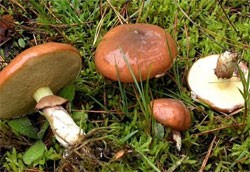Маслёнок (Yellow pig)
- Division: Basidiomycota (Basidiomycetes)
- Subdivision: Agaricomycotina (Agaricomycetes)
- Class: Agaricomycetes (Agaricomycetes)
- Subclass: Agaricomycetidae (Agaricomycetes)
- Order: Boletales (Boletales)
- Family: Suillaceae
- Genus: Suillus (Oiler)
- Type: Suillus luteus (Real butterdish)
- Butter dish ordinary
- Butter dish yellow
- Oiler late
- Autumn butterdish
- Yellow mushroom
- Boletopsis lutea
 Real butterdish (Suillus luteus) – the scientific name of the most common type of oil. The word luteus in the mushroom’s scientific name means “yellow”.
Real butterdish (Suillus luteus) – the scientific name of the most common type of oil. The word luteus in the mushroom’s scientific name means “yellow”.
Growth:
The real butterdish grows on sandy soil from the end of May to November in coniferous forests. Fruiting bodies appear singly or most often in large groups.
Hat:
The hat of the present butterdish (Suillus luteus) reaches a diameter of up to 10 cm, convex, later almost flat with a tubercle in the middle, sometimes with curved edges, chocolate-brown, sometimes with a purple tint. The skin is radially fibrous, very slimy and easily separated from the pulp. The tubules are initially pale yellow, later dark yellow, attached to the stem, 6-14 mm long. The pores are small, pale yellow in young mushrooms, later bright yellow, brown-yellow. The tubular layer adhering to the stem is yellow, the pores are whitish or pale yellow at first, then yellow or dark yellow, small, rounded.
Leg:
Cylindrical, solid, 35-110 mm high and 10-25 mm thick, lemon yellow above, brownish and longitudinally fibrous in the lower part. A white membranous coverlet, which initially connects the stem to the edge of the cap, leaves pieces on the stem in the form of a black-brown or purple ring. Above the ring, the leg is mealy.
Pulp:
The cap is soft, juicy, slightly fibrous in the stem, whitish at first, later lemon-yellow, rusty-brown at the base of the stem.
Spore powder:
Brown.
Disputes:
The real butterdish is very similar to the red butterdish (Suillus fluryi), which is distinguished by the absence of a ring on the leg. It has no resemblance to poisonous mushrooms.
Butterdish real – An edible, tasty mushroom of the second category, in taste it is very close to porcini mushrooms. It is better to remove the skin from the cap before use. It is used dried, fresh, pickled and salted. Very tasty and easily digestible mushroom. It is used to prepare soups, sauces and side dishes for meat dishes. To be marinated.
The optimal average daily temperature for fruiting the butter dish is +15…+18°C, but the ordinary butter dish does not react strongly to temperature fluctuations. Fruiting bodies usually appear 2-3 days after rain, strong dews also stimulate fruiting. In mountainous areas, butterworms can massively grow around stones, this is due to moisture condensation on the surface of the stone. Fruiting stops at a temperature of -5 ° C on the soil surface, and after freezing of the upper layer by 2-3 cm, it no longer resumes. In the summer period (at the beginning of the season), butterflies are often damaged by insect larvae, sometimes the proportion of “wormy” butterflies unsuitable for food reaches 70–80%. In autumn, insect activity decreases sharply.
The real butterdish is widely distributed in the Northern Hemisphere, prefers a moderately cold climate, but is also found in the subtropics, sometimes accidentally introduced by humans into tropical regions, where it forms local populations in artificial pine plantations.
In Our Country, oilseeds are widely distributed in the European part, the North Caucasus, Siberia, and the Far East. Fruits more often in large groups.
Season June – October, massively from September.









